

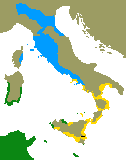 530-510 BC |
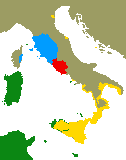 390-375 BC (Dionysius I) |
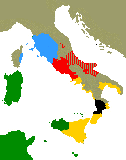 302 BC (Agathocles) |
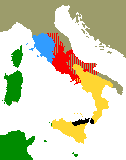 280-275 BC (Pyrrhus) |
 241 BC |
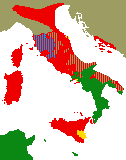 215-212 BC (Hannibal) |
 212-... BC |
 © John E. van Wielink |
530-510 BC
In the 6th century BC a balance had arisen between the powers of the Etruscan cities, the Greek cities and Carthago. The expansion of the Etruscans had come to an end by the foundation of Marseille (Phokaian colony, c. 600 BC) and other cities along the Ligurian coast, by the raising power of Carthago who organised the Phoenician colonies in the West and by the colonisation of the Eolian islands by Knidians and Rhodians (c. 580 BC). This last colonisation was disputed by the Etruscans for the entire 6th century BC.
The most important Etrurian cities were Caere and Vulci. Earlier Tarquinia and Vetulonia were the leading cities (8th and 7th century BC). Mastarna from Vulci is identified with Sevius Tullius who possibly took over the power in Rome from the Tarquinii.
Modern Calabria (the original and real Italy) was in the hands of Rhegium and Locri, especially after the siege over Kroton at the river Sagra (c. 550 BC). After the siege over Siris (c. 550) Sybaris became the leading power in the South. With her colonies Laus, Pyxus and Paestum, Sybaris controlled the trade with Campania and beyond.
Between the different powers there were diplomatic, religious, cultural, artistic and economical contacts. Between Etruria, Sybaris and Milete there was a close contact. The poet Ibicus from Rhegion was invited on Samos by the tiran Polycrates. The Samian philosopher Pythagoras migrated to Italy. Artists from Ionia went to Etruria and the Greek cities in the West.
The balance between the powers was disturbed by the foundation of Alalia (Phocaean c. 565 BC). on the east coast of Corsica. Large numbers of refugees from Phocaea, who had fled from Asia Minor following the Persian conquest (545 BC) leaded to raids on the Etruscan coast. Since also the expansion of Carthago on Sardinia (since 8th century) was threatened (Olbia on the NE coast of the island points to the presence of Phocaeans), Etruscans and Carthagenians forced the Phocaeans to abandon Alalia, after the naval battle of Alalia (c. 540 BC, each 60 ships). The Phocaeans took refuge first in Rhegium, but later founded a new colony at Elea (Hyele in Herodotus, Latin Velia, 535-530 BC), probably with approve of Poseidonia (Paestum). The Etruscans now founded Nicaea (possibly on the same place as Alalia) and the Carthaginians tried to conquer Sardinia on the native population (Nuraghe-culture). They succeeded only at the end of the century. Possibly the natives, were supported against Carthago by Paestum and Sybaris. This support stopped after the defeat and destruction of Sybaris by Kroton in 510-509 BC.
Italic Expansion, the expansion of Italic people, that is all peoples that spoke Osco-Umbrian dialects. These peoples can thus be identified in the 5C BC, but must have been in Italy since at least the Bronze Age. The name Oscan is misleading, since its speakers were not Osci (Opici), but conquerers of the Osci. The Romans called them Samnites.